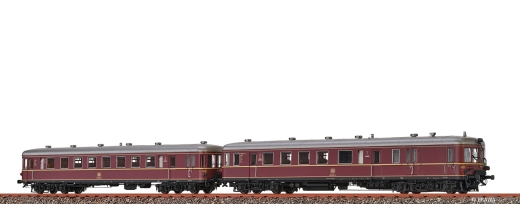Settings
Shipping country
Languages
- Products description
Products description
BRAWA 44710 - H0 BR 660 combustion railcar and BR 945 DB sidecar (double unit)
Model information
Based on a development draft by the Westwaggon company, which, together with Waggon- und Maschinenfabrik AG and Düsseldorfer Waggonfabrik, is responsible for the production of the new branch line railcars VT 137 347 - 366 and 137 377 - 396, the industry put the last large series of typical representatives of the light railcars on the rails between 1939 and 1940. The basis for this was the Deutsche Reichsbahn's (DR) procurement program from 1936, which ensured the constant further development of railcars until then. Typical for the time, the distinctive basket arch shape with the large buffers characterized the front of the vehicle and allowed the staff to get to the neighboring vehicle while driving through a corresponding transition on the front sides. According to their design designation BCPw4itrvT-36, they had a 2nd class (B) compartment with 6 padded seats and a 43-seat 3rd class (C) compartment. These were equipped with wooden seats. They also had a luggage compartment (Pw) that was located behind the front driver's cab. The Maybach GO56 h engine, which was certainly not as well insulated as it is today in terms of noise and heat generation, also protruded from below into the driver's cab and was covered accordingly in the interior. The power from the 225 hp engine was transmitted via a Voith gearbox to the first axle of the front bogie and helped the VT reach a top speed of 80 km/h. The paintwork in beige and wine red, with black cover strips and a light roof clearly followed the color specifications for vehicle paintwork at the time. The beginning of the war in 1939 destroyed the DR's original settlement plans. Although the first railcars arrived at the Fulda and Heidelberg depots as planned, the subsequent deliveries were divided equally between the Reichsbahn directorates in Hanover, Cologne and Saarbrücken. It is obvious that not many railcars were put into regular service, but were primarily used for military purposes. However, that changed suddenly after the end of the war. After the railcars were taken over by the newly founded Deutsche Bundesbahn (DB), several design changes were made in the 1950s in order to make the vehicles, now known as VT60.5, fit for the coming period of operation. In the Aw Friedrichshafen, the engines were exchanged for the 330 hp MAN engines that were already used in small locomotives in performance group III. The upholstery of the upgraded 3rd to 2nd class also increased comfort for the passengers. In the 1960s, many railcars also received modern DB lamps for better route visibility and lost the conspicuous railcar lamps of the Reichsbahn era. The uniform purple red for DB diesel vehicles soon replaced the old DR color scheme. In contrast to the initial home, the DB distributed its 31 VT60.5s to significantly more operating locations and from now on the depots Rheine, Darmstadt, Stuttgart, Kassel, Frankfurt-Griesheim, Heilbronn, Nuremberg and Friedrichshafen were among the main locations. Six railcars were rented to the American occupying forces until 1960. With increasing age, the number of VT60.5s dwindled in the mid-1960s and the Rheine depot practically became the discontinuing depot for the last old DB railcars. At the beginning of the 1970s, the number of vehicles was at its highest here at six. Four more were stationed in Nuremberg and one each in Heilbronn and Kassel. By 1972, these 12 railcars, now referred to as the 660 series in EDP terms, were no longer in regular service. Converted into radio measurement vehicles, the former 660 506 and 660 531 remained in service until 1979. Only VT 60 531 has been preserved to this day. After the war, only three railcars remained in the Soviet occupation zone: 137,348, 137,366 and 137,387. The operations took place here from the Aschersleben depot. However, due to the poor availability of spare parts, the railcars were all out of service by 1969. In parallel to the 40 railcars, the procurement plan also included suitable VS145 control cars, especially for the VT137 347 - 366 and 137 377 - 396. The cars ordered according to sketch sheet CPost4ivS-36 had 76 3rd class seats, a control compartment in the front and a postal compartment in the rear. Since the control cars were largely delivered at a different time to the VT, the planned combinations did not materialize from the start. Rather, the freedom to use the VS with other VT types was used. During the Federal Railway era, a total of 10 VS145s are documented for 1952, which were primarily used in association with the VT60.5. In Bremen and Wuppertal, however, operations were also carried out with VT36.5 or V36. Together with the last VT60.5, the last VS145 was now referred to as the 945 series and was decommissioned in Rheine in 1972.
Model details
Drive on two axles
Individually attached and free-standing handlebars and steps
Epoch-appropriate lighting
Finely detailed bogies
Finest engravings
Cab lighting
Prepared for sound, or installed
Gear block made Zinc die-cast
Interior lighting
Short coupling kinematics
Multiple interior fittings
Prototypical corrugated wheel discs
Technical details
Length over buffer: 506 mm
Minimum passable radius: 360 mm
Interface: PluX22
Number of traction tires: 2
Flywheel: built-in
Light change: triple headlights & two red marker lights changing in the direction of travel
Interior lighting: built-in
Short coupling kinematics: built-in
Sound: built-in
Decoder (Döhler+Haass): built-in
Characteristics:
| Manufacturer: | BRAWA |
| Item number: | 44710 |
| number of pieces: | 1 piece |
| EAN: | 4012278447100 |
| track: | H0 |
| scale: | 1:87 |
| model series: | BR VT60.5 railcar |
| Company number: | 660 516-6 / 945 832-4 |
| Railway company: | DB |
| country: | EN |
| epoch: | IV |
| Electricity system: | DC |
| operation mode: | DC Digital EXTRA |
| interface: | PluX22 |
| Digital decoder: | built-in |
| engine: | pole motor |
| Motor with flywheel: | built-in |
| traction tires: | 2 |
| Length over buffers: | 506mm |
| Minimum radius: | 360mm |
| coupling: | NEM 362 shaft with KK kinematics |
| Interior lighting: | built-in |
| Cab lighting: | digitally switchable |
| Top light: | Triple headlights & two red marker lights that change in the direction of travel |
| sound: | built-in |
| Age recommendation: | 14 years and older |
| WEEE no.: | DE14862574 |
Information according to GPSR
Manufacturer contact details
BRAWA Artur Braun Modellspielwarenfabrik GmbH & Co. KG
Uferstraße 24-30
73630 Remshalden
Deutschland
Website: www.brawa.de
E-mail addres: info@brawa.de
Telephone: +49 (0)71 51-979 35-0
Fax: +49 (0) 71 51-746 62
For further information, please visit the homepage of this product.
This Product was added to our catalogue on 02/03/2024.
Last viewed:





















